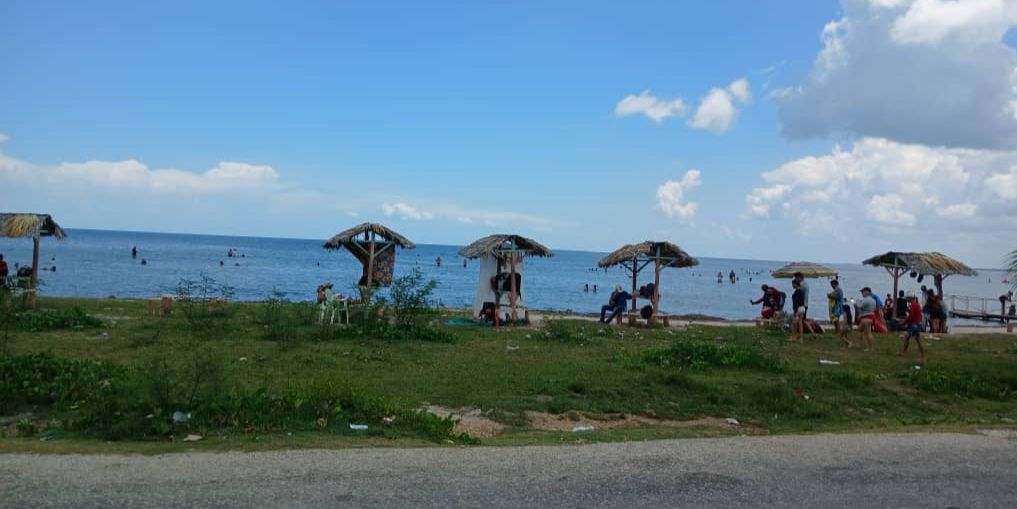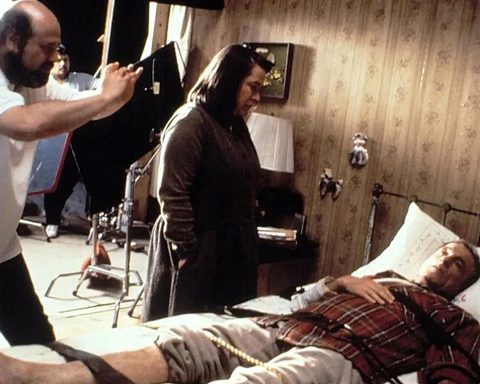SANTA CLARA, Cuba. – Around 4:30 in the morning, a group of people gathered in front of the Audiencia de Cuba park. Saint Clare waiting for the transport that will take him to the beach. In the darkness, the hustle and bustle of the rather unlikely items can be seen: a sofa with a mattress, rechargeable fans, two chairs, an extension cord that is more than three metres long.
At the appointed time, the driver appears with an assistant who charges those present the amount of 1,500 pesos per passenger and explains to them that for a little more money (about 600 extra) they can receive a can of soda and a ham and cheese sandwich during the trip, but most seem to decline the offer.
In Revolico Private offers for this type of excursion are plentiful on WhatsApp and, although they are not cheap, they at least guarantee a day at the beach for families who cannot afford to stay in hotels or book a pool at private homes. The manager of this trip boasts of having transported thousands of people on various routes in the months of July and August: “I earn my money, but if it weren’t for these rented cars, people wouldn’t even go out of their backyard,” boasts the man who receives the largest percentage of the business.
It is just dawning and the bus arrives without any problems to the coasts of Corralillonorth of Villa Clara and more than 70 kilometers from the exclusive resort of Varadero. Half asleep and without much anticipation, more than 30 people get off the car: some children under five years old, several men who have downed a liter of rum during the trip and a rather elderly lady whose job will be to look after her family’s belongings while the others enjoy themselves.
Several communities of bathers have previously occupied the few thatched-roof umbrellas on the shoreline. The newcomers, who are prepared for this type of contingency, stretch sheets under the hidden grapes, use pieces of nylon as a roof, and others collect trunks and branches to build their improvised huts. They all help each other in preparing their respective shelters before the unbearable summer sun hits. Seen from a distance, the edge of El Salto beach resembles a carnival-like “come and go” with no shortage of public bathrooms and stalls of all kinds.

The sand on that stretch of coast is full of sargassum, rubbish, and empty cans. The water is not very clear. There, at the so-called Nautical Point, almost all the travellers from nearby towns meet up with those who have dared to stay at the nearby popular campsite in the midst of blackouts, mosquitoes and shortages.
“During the holidays, this place doesn’t empty out,” confirms Gilberto Cairo, an ice cream vendor. frozen in the area. “People don’t go to Ganuza because there is nothing to eat there, even though the beach is better. This is where the atmosphere is, you know?” Cairo also points out that, for many self-employed people in Corralillo and Santo Domingo, summer is the opportunity to earn some extra income: “The economic life in these towns is dead, the beach is what saves us to make some money.”


Along the road there are more than 10 private stalls selling snacks, pizzas, boxes of food and lots of cold beer and soft drinks. In the only state-run cafeteria you can see a menu with boiled sweet potato, yuca with mojo sauce and pork fricassee for 370 pesos, although there doesn’t seem to be anyone ordering the aforementioned lunch, which suggests its dubious quality and quantity. The offer on the beach is governed solely by private prices: a bottle of drinking water is sold for 200 pesos and there is no other option other than this to quench your thirst.
One camper complains that she has spent “an unspeakable amount” in less than three days staying in Ganuza. “At the Camp Base there is hardly anything to eat and the little they sell is not cheap either, like soft drinks or cookies for the kids,” laments the woman who introduces herself as Niury Mendoza. “And not to mention that you have to carry water to bathe and that the mosquitoes lift you up when the power goes out. The truth is that we came here to suffer. This is what we ordinary Cubans have to do.”

Unlike the case of Isabella of Sagua and Caibarienalso in Villa Clara, near El Salto and Ganuza, there is no community or town nearby. From the group of cabins on the edge of the beach, guests must walk one kilometer to the nearest point of sale to have lunch or buy a drink.
Until the 1980s, these beaches were divided by a canal and occupied by more than a hundred recreational homes built by fishermen and families from Santa Clara, almost all of which perished after Hurricane Kate in November 1985. Although some had preserved their foundations and façade, their owners were prohibited from rebuilding them or living there, on the grounds that they were “dangerous” due to the proximity of the sea and because it was, they said, a “petty bourgeoisie rest area.”
Since then, El Salto and Ganuza have only been accessed by private or rented transport, and therefore there are no nearby places to spend the night or to take shelter from the rain in the event of a sudden storm. “At least there are things to eat here, even if they are expensive,” says William Rodríguez, who moved from Los Arabos with his family. “Last year we paid a lot for a day in Varadero, to remember what it was like, and we were really hungry. All there is is hotels and hotels.”


After midday, the crowd of bathers leaves the water to eat lunch. The old woman from Santa Clara who was looking after their belongings warns her relatives that the rice does not smell good. Resigned, they prepare to buy five pizzas whose total cost amounts to almost 1,000 pesos. Under the few roofs of the state establishments, people try to rest lying in the shade of the ground and some wait for the transport that will take them back.
At 4:00 p.m. the paid excursion ended. For some of the travelers who returned to the bus with their faces long, it was a torturous day, with excessive expenses that they had not anticipated and could not afford. More than a pleasant outing, a day at the beach for Cubans who travel from far away represents a huge investment and the only recreational opportunity they had all summer.















